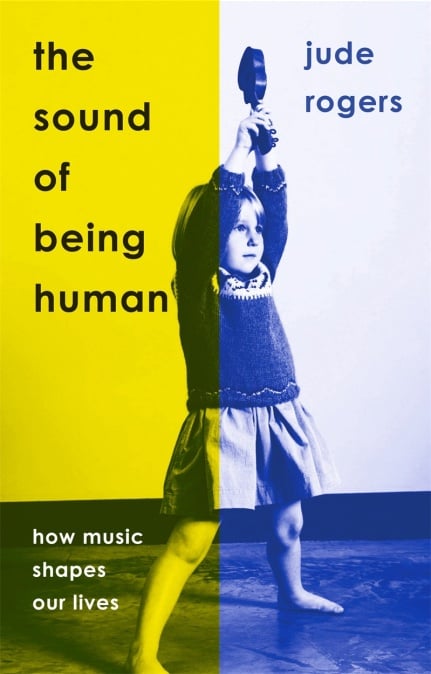
Jude Rogers
The Sound of Being Human: How Music Shapes Our Lives
Orion Publishing Co
2022
In Jude Rogers’ sweeping, often raw, but decidedly life-affirming book The Sound of Being Human: How Music Shapes Our Lives, she has an exchange with science writer Philip Ball who says: “One of the reasons music is so important personally and culturally, [is] because it can express things that are beyond words.” In many ways, the point sums up Jude’s core proposition for the book.
Journalist Jude Rogers has been writing about music since 2003, and The Sound of Being Human is her first book. Like a mixtape, the book is shaped around 12 songs and is in many ways three books in one: the personal context and meaning of each song, not shying away from sharing moments of loss and trauma; a dive into the story of the artists themselves, situating the track in the perspective of their life and musical career, and; explorations into a myriad of writings about the how and why music affects us it as it does, as Jude puts it “to cast different degrees of illumination on music’s many mysteries”.
In a heart-breaking opening Jude tells the story of her dad’s wholly unexpected death at the age of thirty-three when she was just five. That loss, the love of pop music that Jude and her dad shared, and trying to make sense of that experience, is a key emotional, episodic thread throughout the book. In the first instance, she is explicitly telling her story to him, and it is a profoundly moving journey.
‘Track 9 – Among Angels by Kate Bush’ includes the story of the emotional turmoil of a miscarriage when, at her most vulnerable, Jude has to do “the biggest interview” of my life” with Paul McCartney. During another difficult pregnancy, Jude tries to lose herself in work, gigs and songs at the same beats per minute as her baby’s heartbeat. After the birth of her son, she was hit by post-natal depression, and she describes beautifully how listening to the Kate Bush song at a live show connected entirely with her emotional whirl and, unexpectedly, helped her to move beyond that very tough time.
One of the joys of this book is that it repeatedly activates your musical memories and associations with significant life stages or events, however different the specific experiences might be. The part that music plays in the relationships between parents and children pops up on many tracks. There is a fascinating study of how babies remember music they hear in utero after they are born – my son always moved about, danced even, in his mum’s womb whenever he heard Bill Malley’s Barndance, the first tune on Martin Hayes’s 1995 album Under The Moon and is still a fan 25 years later. Similarly, babies understand and are soothed by music before they know verbal language, which is why we sing to them.
On ‘Track 7 – Heatwave by Martha Reeves and the Vandellas’ Jude jumps into how love songs can “give us a place to put out compulsions”, as often as not, and frustrating as it might be, in our heads rather than shared with the object of our desires. I could only too fully relate to a “singer suddenly articulating words we could not or dare not express”. Motown, of course, brings in the vitality of dancing to music and the memories of dancing to particular tracks at particular moments in our lives. I love how Jude recognises the brilliant, often unnamed musicians who played on Heatwave and countless other Motown hits, not least bass player James Jamerson, who she describes perfectly as providing “the agile backbone to some of the world’s greatest love songs”.
‘Track 8 – Gilderoy by Shirley and Dolly Collins’ begins with Jude singing that very song herself in the basement at Cecil Sharp House, in the service of a piece for the Guardian about swapping places with people she interviewed, the song having been chosen for Jude to sing the interviewee Shirley Collins. In this 21-page absorbing chapter, Jude, without stopping for a breath, moves from her traditional folk song singing debut to interviewing Shirley; briefly telling Shirley’s own fascinating story; Jude’s music writing career; the provenance of the song and a sketch of Lucy Broadwood who collected the version Jude and Shirley sang.
The Sound of Being Human covers a wide range of meanings that music has had and continues to have for Jude in her life and, more generally, has for the rest of us. She has read extensively, and her meanderings through various sources and conversations with experts are always pithy and accessible. Her approach is in no sense scattergun – there are relative tangents, but they only add to the depth and richness of the narrative, and the combination of strands in each chapter is thoroughly engaging. This is just as true when the song itself wouldn’t necessarily command your attention. Despite Jude encouraging readers to listen to the songs, I didn’t, for the most part, feel any great need to do that beyond the tracks that I already knew. That’s because the specific tracks are a playlist to Jude’s life, with the significance they have for her; the writing is as engaging on the Adam and the Ants track, which I can live without, as it is on the Toots and the Maytals track, which is one of my life’s necessities.
If you love music and sometimes muse over why it occupies such an important place in your life, you will revel in and happily lose yourself in this glorious jukebox of a book.
The Sound of Being Human is out now. Order it here

